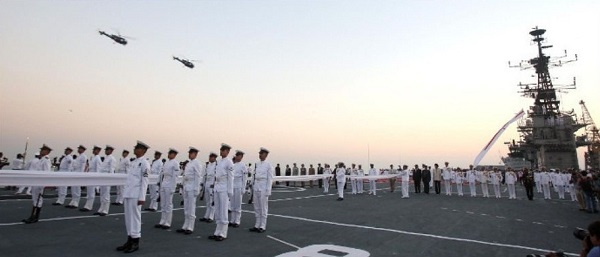(Asian independent) Indias second aircraft carrier, the mighty INS Viraat, was decommissioned after 30 years of glorious service to the nation. This article is a tribute to this unique warship, which kept Indias shores safe and citizens protected during one of the most challenging times in our nations history.
Thus, this article intends to rewind the clock and take a peek at those glory days through the eyes of one of its Captains who commanded INS Viraat when it was in full sail on the Indian high seas.
First, a short backgrounder. The ship was constructed by the Vickers-Armstrong shipbuilders in Great Britain and commissioned into the Royal Navy as HMS Hermes in 1959. She was the Royal Navy’s flagship during the Falklands War in 1982, before being decommissioned in 1985.
The ship started her second innings with the Indian Navy, when she was commissioned as INS Viraat on May 12, 1987 as India’s second aircraft carrier. Those were the heady days when India was operating two aircraft carriers — INS Vikrant and INS Viraat.
INS Viraat was different in that it was larger and operated the Sea Harrier fighter, which was a Short Take Off and Vertical Landing (STOVL) aircraft. INS Viraat remained the flagship of the Western Fleet of the Indian Navy for most part of her 30-year service during which she proudly displayed the Indian naval ensign in many parts of the world, while also taking part in numerous operations which included Operation Jupiter in 1989 during the Sri Lankan Peacekeeping operation and Op Parakram in 2001-2002, post the terrorist attack on the Parliament. The ship was decommissioned on March 6, 2017 after almost 30 years of glorious service with the Indian Navy.
Vice Admiral Abhay R. Karve, PVSM AVSM (Retd), commanded the ship as its Captain from August 1, 2007 to December 27, 2008. He later went on to be the Flag Officer Commanding-in-Chief, Southern Naval Command, from 2016 to 2018, from where he retired.
Considering his extensive sea experience and varied command tenures, we took the opportunity to seek his unique experience on his command of the mighty Viraat. Reproduced below are excerpts of that interview.
Starting with the basics, we asked for the Admiral’s views on the difference he found in commanding an aircraft carrier vis-a-vis other ships.
Karve replied, “An aircraft carrier has the largest crew complement of any ship in the Navy, which amounts to more than 1,500 personnel when all aircraft Squadrons are embarked. For a Captain, its ship handling characteristics are completely different from other ships. The aircraft carrier embarks various types of aircraft viz Sea Harrier fighters, Sea King helicopters, Chetak and even Kamovhelicopters at times. Other ships of the fleet are required to operate in coordination with the aircraft carrier. The safety and operational ability of such a large crew is the Captain’s responsibility.”
Having set the tone, we asked him about the unique characteristics of flying aircraft from sea and more so, from an aircraft carrier.
The Admiral said, “Every aircraft has its own unique role at sea. This requires specialized personnel to operate and maintain each aircraft. Moreover, the ship’s air wing and the operations team have to work like a well-oiled machine in complete coordination to maintain the tempo of operations. For me, since I had served on the ship as part of the commissioning crew, one was fairly aware of carrier operations and thus one could benefit from that experience when I commanded the ship.”
Turning from operations to the more basic necessities of food and water, we asked him how such a large force of men were fed and clothed while being fighting fit at such a large distance into the sea for months at a time.
Karve explained, “Onboard an aircraft carrier, stocking of rations and ammunition is a massive evolution requiring a few days of whole ship involvement. Fueling in harbour and at sea is also a unique exercise for the carrier which can be extremely stressful for the crew and Captain who are always alert for any emergency.”
Our final question was on the unique problems that an aircraft carrier faces while at sea. To this, the Admiral had an interesting insight to share.
“One of the unique challenges of the carrier at sea is the sea-space it requires. The ship must remain on steady course and speed for a longtime during launch recovery operations. Other vessels, including fishing boats, are required to stay clear of the carrier conducting flying operations. This may not always be possible and therefore can pose navigational challenges to the carrier, especially during night flying operations,” he said.
“Aircraft carriers are central to the concept of Indian naval operations. The carrier is an extremely versatile platform and with its integral air power is able to exercise sea control over vast stretches of the ocean at will,” Karve added.
This reinstates the vitality of aircraft carriers. Carriers are no doubt expensive but the unique capability that they provide to the Navy is unmatched and unachievable by other ships or capability.
Currently, India has one aircraft carrier in commission, INS Vikramaditya, while the new Vikrant is undergoing sea trials and would be commissioned shortly. A follow-on third aircraft carrier is an operational necessity for the Indian Navy and is under active consideration.
Meanwhile, INS Viraat will remain a milestone in India’s maritime history. Today, we honour this mighty warrior on its decommissioning anniversary and pledge never to forget its great service to the nation.








